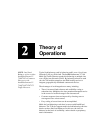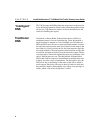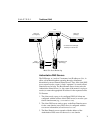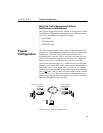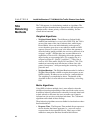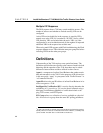
C H A P T E R 2Intel® NetStructure™ 7190 Multi-Site Traffic Director User Guide
8
4. The client DNS server sends a query to the mstd-ex.com
Authoritative DNS server to resolve www.mstd-ex.com.
5. The Authoritative DNS server responds to the client DNS server
with the IP address of www.mstd-ex.com.
6. The client DNS server responds to the client with the IP address
of www.mstd-ex.com.
In the discussion above, the 7190 acts as authoritative DNS server for
zone.mstd-ex.com, which is the zone in which the name www.mstd-
ex.com resides.
Multi-Site
Traffic
Management
Using Intel
Load
Balancers
Multi-site load balancing solves most of the problems inherent in
Round Robin DNS. Under the server load balancing model, servers
are aggregated in a “server farm” behind a load balancer known by a
Virtual IP address or “service.” (The service is the IP address of
which the external network is aware.) By keeping track of such
metrics as number of connections, which services are running,
response time and the like, the load balancer knows the status of the
servers. The 7190 retrieves metrics from the load balancer. Thus,
when a client requests the service, the 7190 routes it to the site who
has a server best able to fulfill it.
If the data center has an Intel Load Balancer, the 7190 works in
concert with the “agents” in the load balancers by continually
communicating with each site’s agent through site verification
protocol. This keeps the 7190 informed of the following:
• Health of the load balancers.
• Individual service health and availability.
• CPU utilization of load balancers (as of 7140/7170, 7180
Software release 2.2.1)
• Response time for each service (as of 7140/7170, and 7180
software release 2.3)
• Number of connections to each load balancers (as of 7140/7170,
and 7180 software release 2.2.1)
Site verification protocol information is encrypted for secure
communication between an Intel Load Balancer and the 7190.








